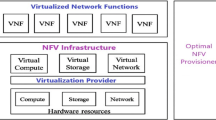Abstract
The conventional mobile architecture is unlikely to cope with Ultra-Reliable Low-Latency Communications (URLLC) constraints, being a major cause for its fundamentals to remain elusive. Multi-access Edge Computing (MEC) and Network Function Virtualization (NFV) emerge as complementary solutions, offering fine-grained on-demand distributed resources closer to the User Equipment (UE). This work proposes a multipurpose analytical framework that evaluates a hybrid virtual MEC environment that combines VMs and Containers strengths to concomitantly meet URLLC constraints and cloud-like Virtual Network Functions (VNF) elasticity.





Similar content being viewed by others
References
Feng D et al (2019) Toward ultrareliable low-latency communications: typical scenarios, possible solutions, and open issues. IEEE Veh Technol Mag 14(2):94–102. https://doi.org/10.1109/MVT.2019.2903657
Antevski K, Bernardos C, Cominardi L, Oliva A, Mourad A (2020) On the integration of NFV and MEC technologies: architecture analysis and benefits for edge robotics. Comput Netwo 175:1286–1389. https://doi.org/10.1016/j.comnet.2020.107274
Kaur K, Dhand T, Kumar N, Zeadally S (2017) Container-as-a-service at the edge: trade-off between energy efficiency and service availability at fog nano data centers. IEEE Wirel Commun 24(3):48–56. https://doi.org/10.1109/MWC.2017.1600427
Sultan S, Ahmad I, Dimitriou T (2019) Container security: issues, challenges, and the road ahead. IEEE Access 7:52976–52996. https://doi.org/10.1109/ACCESS.2019.2911732
Santoyo-Gonzlez A, Cervell-Pastor C (2018) Edge nodes infrastructure placement parameters for 5G networks. In: IEEE Conference on Standards for Communications and Networking (CSCN) pp. 1–6. https://doi.org/10.1109/CSCN.2018.8581749
Li C, Cai Q, Zhang C et al (2021) Computation offloading and service allocation in mobile edge computing. J Supercomput. https://doi.org/10.1007/s11227-021-03749-w
Yala L, Frangoudis PA, Ksentini A (2018) Latency and availability driven VNF placement in a MEC-NFV environment. In: IEEE Global Communications Conference (GLOBECOM), pp. 1–7. https://doi.org/10.1109/GLOCOM.2018.8647858.
Farhadi V. et al (2019) Service placement and request scheduling for data-intensive applications in edge clouds. In: IEEE Conference on Computer Communications, pp. 1279–1287. https://doi.org/10.1109/INFOCOM.2019.8737368.
Samanta A, Tang J (2020) Dyme: dynamic microservice scheduling in edge computing enabled IoT. IEEE Internet Things J 7(7):6164–6174. https://doi.org/10.1109/JIOT.2020.2981958
Lee S, Lee S, Shin MK (2019) Low cost MEC server placement and association in 5G networks. In: International Conference on Information and Communication Technology Convergence (ICTC), pp. 879–882. https://doi.org/10.1109/ICTC46691.2019.8939566.
Emara M, ElSawy H, Filippou MC, Bauch G (2021) Spatiotemporal dependable task execution services in MEC-enabled wireless systems. IEEE Wirel Commun Lett 10(2):211–215. https://doi.org/10.1109/LWC.2020.3024749
Tong Z, Zhang T, Zhu Y, Huang R (2020) Communication and computation resource allocation for end-to-end slicing in mobile networks. In: IEEE/CIC International Conference on Communications in China (ICCC), pp. 1286–1291. https://doi.org/10.1109/ICCC49849.2020.9238794.
Sarrigiannis I, Ramantas K, Kartsakli E, Mekikis P, Antonopoulos A, Verikoukis C (2020) Online VNF lifecycle management in an MEC-enabled 5G IoT architecture. IEEE Internet Things J 7(5):4183–4194. https://doi.org/10.1109/JIOT.2019.2944695
Kherraf N, Alameddine HA, Sharafeddine S, Assi CM, Ghrayeb A (2019) Optimized provisioning of edge computing resources with heterogeneous workload in IoT networks. IEEE Trans Netw Serv Manag 16(2):459–474. https://doi.org/10.1109/TNSM.2019.2894955
Ma S, Chen X, Li Z et al (2019) Performance evaluation of URLLC in 5G based on stochastic network calculus. Mobile Netw Appl. https://doi.org/10.1007/s11036-019-01344-1
Ren Y, Phung-Duc T, Chen J, Yu Z (2016) Dynamic auto scaling algorithm (DASA) for 5G mobile networks. In: IEEE Global Communications Conference (GLOBECOM), pp. 1–6. https://doi.org/10.1109/GLOCOM.2016.7841759.
Morabito R (2015) Power consumption of virtualization technologies: an empirical investigation. In: 2015 IEEE/ACM 8th International Conference on Utility and Cloud Computing (UCC), pp. 522–527. https://doi.org/10.1109/UCC.2015.93.
Anand A, de Veciana G (2018) Resource allocation and HARQ optimization for URLLC Traffic in 5G wireless networks. IEEE J Sel Areas Commun 36(11):2411–2421. https://doi.org/10.1109/JSAC.2018.2874122
Li W, Jin S (2021) Performance evaluation and optimization of a task offloading strategy on the mobile edge computing with edge heterogeneity. J Supercomput. https://doi.org/10.1007/s11227-021-03781-w
Kleinrock L (1975) Queueing systems theory, vol 1. Wiley, New York
Lal S, Ravidas S, Oliver I, Taleb T (2017) Assuring virtual network function image integrity and host sealing in Telco cloud. In: IEEE International Conference on Communications (ICC), pp. 1–6. https://doi.org/10.1109/ICC.2017.7997299.
Acknowledgements
This work was supported by the National Council for Scientific and Technological Development (CNPq) Project No. 433142/2018-9, the CNPq Research Productivity Fellowship (Grant No. 312831/2020-0) and the Pernambuco Research Foundation (FACEPE) (Grant No. IBPG-0096-1.03/16).
Author information
Authors and Affiliations
Corresponding author
Additional information
Publisher's Note
Springer Nature remains neutral with regard to jurisdictional claims in published maps and institutional affiliations.
Rights and permissions
About this article
Cite this article
Falcao, M., Souza, C.B., Balieiro, A. et al. An analytical framework for URLLC in hybrid MEC environments. J Supercomput 78, 2245–2264 (2022). https://doi.org/10.1007/s11227-021-03945-8
Accepted:
Published:
Issue Date:
DOI: https://doi.org/10.1007/s11227-021-03945-8




